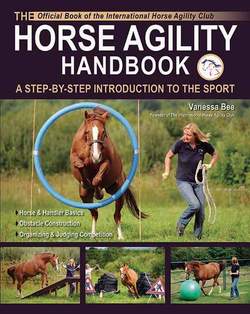Читать книгу The Horse Agility Handbook - Vanessa Bee - Страница 10
Оглавлениеxii
introduction to horse agility
At your direction—and without a lead rope—a free horse jumps through a hoop in an open field that’s full of delicious grass. It sounds impossible, doesn’t it? Up until a few months ago I would have thought so too, but now I can direct my horse round an obstacle course with jumps, tunnels and weaving poles, just like in the popular sport of Dog Agility. And the great thing I’ve discovered is that I can teach other people and their horses how to do it, too.
Not only have I found that we have been really underestimating the ability of our horses, we’ve been underestimating ourselves. Helping horses and people discover and learn to do Horse Agility is not difficult, although it takes a little time, of course. The real challenge is exploding the myths people have long believed about horses.
At first, people laughed when I explained what I was doing; they would say things like, “So you want to jump your horse through hoops, do you?” When I replied, “Not only hoops but tunnels and fire pillars, and all with the horse completely free,” they began to realize just how serious I was. As at that point there was nothing remotely like this in the horse world, I thought I’d better take a look at Dog Agility to see how participants trained, handled and competed their dogs—especially as compared to the way we train our horses.
I noticed dog people did not use a leash or other restraint, nor did they wield a whip or stick to hit or threaten a dog when he made a mistake. And, the dogs moved freely with great enthusiasm over the agility course.
Would horses be able to do this? There was only one way to find out—I had to try it!
The ultimate aim of Horse Agility is to work the horse free (at liberty) over obstacles, just as happens in Dog Agility classes. However, as with dogs, you cannot just turn up on the day of competition and think it’s
1
A horse, free, jumping through a hoop at the direction of his handler—is it possible? Yes!
2
going to work! Training horses to do Horse Agility is almost identical to training dogs: First, the dog is taught to be lead. Then, on the leash, he learns how to go over obstacles while the handler uses body language and verbal commands. Later, the trainer turns the dog loose in a safe place and uses the same signals to see if she can still direct the dog over the obstacles.
So that’s what I tried with my horses. And it worked!
How to Use This Book
You will see that The Horse Agility Handbook is divided into a number of chapters. One of the most important, chapter 5 (p. 40), explains how to handle your horse in a safe manner. I urge you not to skip this chapter. The reason I was able to proceed relatively quickly to jumping my horse through a hoop is because my foundation skills are extremely solid. I can look at an obstacle, work out a strategy, piece together all the skills I already have, and then build a plan I can follow to complete the task. I work in tiny sections so it’s a bit like building a pile of paper. Each sheet is very thin, but when you place one on top of another, you create a solid block.
I would also like to suggest that you read the whole book before you start practicing Horse Agility so you can see where it is going. Then, you just start “playing.” There are only two rules: Stay Safe! Have Fun!
3
Introducing the people and horses in this book: Philip Osborne with Ollie (A); Secret, Thoroughbred mare, 14 years old (B); Creedy, Exmoor pony mare, 28 years old (C); Ricky, Exmoor pony gelding, nine years old (D); Emma Tarrant with Kelston (E); Kelston, Appaloosa/Thoroughbred gelding, 14 years old (F); Fudge, Exmoor pony gelding, ninr years old (G); Ollie, Exmoor pony gelding, nine years old (H); Lucy Adams with Fudge (I); Sunday, Thoroughbred mare, 10 years old (J).
